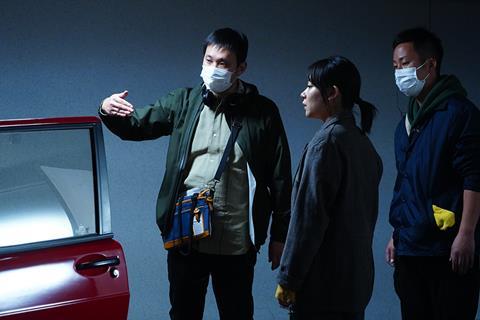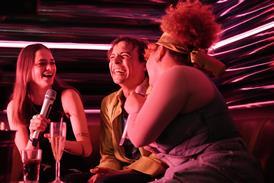Drive My Car has grossed more than $1m at the US box office and earned four Oscar nominations — but the road to glory was far from smooth, say director Ryusuke Hamaguchi, co-writer Takamasa Oe and producer Teruhisa Yamamoto. Screen talks to the trio in the driving seat.

It all started with a hunch. About a decade ago, it struck Japanese producer Teruhisa Yamamoto that a young filmmaker named Ryusuke Hamaguchi might be ideally suited to adapt a story by Haruki Murakami, perhaps Japan’s best-known living author.
“There’s a certain similarity [between the two] in the way they touch on themes like love and sex,” says Yamamoto, who produced Hamaguchi’s 2018 film Asako I & II.
The producer also thought the subject matter would stretch Hamaguchi creatively. “He hadn’t really touched on the subject of death in his narrative films,” says Yamamoto. “Murakami had themes that fit Hamaguchi perfectly and themes that might draw something new out of him. That was my hunch.”
Yamamoto originally suggested another Murakami story, but after much discussion, Hamaguchi suggested Drive My Car, a tale about a theatre director grieving the death of his wife who is chauffeured around Tokyo in a Saab by a mysterious young woman. “I read it and thought it was extremely well-suited to a film adaptation,” says Yamamoto.
Critics and audiences seem to agree. Since its debut at Cannes in 2021, the film has won several major awards, including best screenplay at that festival. It is now nominated for four Academy Awards, including best picture (a first for a Japanese film) and three Baftas — and has exceeded more than $1m at the box office in both the US (for Janus Films) and France (Diaphana Distribution). At home in Japan, the film has taken $4.9m for Bitters End.
But the road to success for Drive My Car was not without a few bumps, including the giant roadblock of Covid-19 that forced a six-month production shutdown and a major retooling of the film’s second half.
During a screenwriting process that looked to bring a short story to feature-film length, Hamaguchi borrowed elements from two other Murakami short stories published in the same collection as Drive My Car. And when he asked Yamamoto to call in “his most trusted screenwriter” to co-write the film, the producer turned to writer and director Takamasa Oe, with whom Yamamoto had worked on 2018 television series Love And Fortune. “We’re of the same generation, and we both came up in independent film,” says Hamaguchi of Oe. “I knew he was knowledgeable about the theatre, so I definitely wanted to write it with him.”
Oe, who also worked as first assistant director on the film, shared Hamaguchi’s enthusiasm for a collaboration. “I always had the impression he was the kind of director who’s really interested in people,” he says. “I was happy to join in if I could help.”
Author’s blessing
When it came to getting permission to adapt the story, Yamamoto knew that while Murakami does not usually allow his novels to be filmed, “From some time ago, he’s allowed independent filmmakers to adapt his short stories, provided they properly explain their intentions.”
Hamaguchi wrote a letter to Murakami doing just that and received a “yes” — with no further comment. Even now, says Hamaguchi, the two creators have not spoken directly about the film, though Murakami has praised it in the press.
“My impression is that Murakami thinks of his short stories as seeds,” says Hamaguchi. “Sometimes, they flower into full-length novels by the author himself, and sometimes they flower into films. It’s as if he lent us one of those seeds and gave us the freedom to raise it however we liked.”
With Murakami’s permission in hand, funding was the next hurdle. “Since it was my second feature with Hamaguchi, I thought funding would be easy, but that wasn’t the case,” says Yamamoto. “With Asako I & II, our budget didn’t quite match the scale of Hamaguchi’s ambition, so for Drive My Car we pushed for a bigger budget but it isn’t easy to secure such budgets in Japan.”
Ultimately, the team turned to Bitters End and Culture Entertainment, both of which had funded Asako I & II. One key to convincing the companies, says Yamamoto, was the Murakami brand name. Another was the casting of Hidetoshi Nishijima, who early on agreed to play the film’s theatre-director protagonist.
“Not only is he one of Japan’s most famous stars, he’s also a huge cinephile who wanted to work with Hamaguchi,” says Yamamoto. “It was a great match creatively, and it helped give the sponsors peace of mind.”
Tale of two cities

Drive My Car largely takes place in two cities: Tokyo, where the main character lives, and Hiroshima, where he directs an internationally cast, multi-language production of the Chekhov play Uncle Vanya, two years after the death of his wife.
Viewing the finished film, it is difficult to imagine the latter section taking place anywhere other than Hiroshima, but the Uncle Vanya production was originally set in Busan, South Korea. The decision to set this section outside Japan, says Yamamoto, came from a very practical reality. “In big Japanese cities, especially Tokyo, it’s extremely difficult to shoot driving scenes. We realised quickly that shooting abroad would make things much easier.”
The team discussed places such as Taiwan and Hong Kong, but decided on South Korea, in part for its reputation as a great place for filmmaking. “Compared to Japan, the facilities for filmmaking are so well-developed there,” says Oe, who visited Busan and wrote his impressions to Hamaguchi in the form of “poem-like” reports. “I felt quite jealous.”
Setting the film in Busan also made sense from a storytelling perspective. “South Korea is a place where you could physically put a car on a ferry and bring it from Japan,” explains Oe. “And it made sense that our main character would go abroad to put on his multi-language play.”
But in March 2020, the Covid-19 pandemic hit, and the production was placed on hold. Soon it was clear that shooting in Busan was no longer an option. “This is bad,” Hamaguchi remembers thinking. “I didn’t know what was going to happen to our film.”
At the same time, the director was never worried that Drive My Car had been dealt a fatal blow. “Of course, Nishijima and the other actors have busy schedules, but everyone felt very excited about the scenes we’d already shot in Tokyo, and there was a lot of passion about the project. That gave me peace of mind that it wouldn’t be cancelled,” he says.
It was decided to shoot the remainder of the film in Japan, but the issue of finding a drivable location remained. Hamaguchi set off to the southern island of Kyushu, but could not find anywhere suitable. Meanwhile, Oe had better luck scouting the prefecture of Hiroshima, which had all the elements the team needed, including a supportive film commission and unique locations such as the Seto Inland Sea.
Six months after the Tokyo section had wrapped, with the setting changed from Busan to Hiroshima, the next challenge was getting the film’s international cast through Japan’s strict pandemic border controls. Here, producer Yamamoto’s personal connections were key.
“That was a tough situation,” says Yamamoto. “By chance I happen to know someone from the Ministry of Economy, Trade and Industry, and when I explained the cultural merits of the project, that person helped us secure visas for the actors.”
Once the cast and crew assembled in Hiroshima in November 2020, shooting began with now-familiar Covid protocols, including masking and physical distancing. The film’s relatively small cast kept risk at a minimum, aside from the scene in which Uncle Vanya is finally performed in front of an audience.
“That required a lot of extras, which was tough, but the Hiroshima Film Commission helped us out, assembling a large crowd while still respecting the protocols,” says Yamamoto.
On set, the international cast, who spoke a total of nine languages, communicated through a team of interpreters. The most complicated piece of the puzzle involved going from Japanese to Korean to Korean sign language and back, which meant conversations took two to three times longer. But Hamaguchi says the cast’s skill and passion for the material overcame any communication difficulties.
In rehearsal, the actors workshopped the script in the same way their characters workshop Uncle Vanya in the film, sitting around a table and reading their lines over and over. But Hamaguchi contrasts his directing style with that of Nishijima’s character in the film.
“I don’t think we’re much alike at all,” Hamaguchi says. “The fact [the character and I] are of different generations is one big difference. Theatre directors of his generation didn’t feel the need to explain things to actors. That lack of expressiveness became a big part of the character.”
Honing the edit
With Drive My Car in the can, the next challenge came when Hamaguchi’s initial edit ran well over three hours. “When the script was finished, I thought it would be about two-and-a-half hours,” says Yamamoto. As filming progressed, he says, he started to realise it might be closer to 165 minutes — a length that made him nervous but one he could “still explain to the production committee [made up of representatives of the film’s investors]”.
On set, the producer and director agreed to aim for two-and-a-half hours, and not exceed three. But during the edit Yamamoto got a pained call from Hamaguchi, saying it was running to three-and-a-half hours.
“I said something like, ‘That’s no good! We’re going to be in big trouble!’” Yamamoto laughs. “I knew the film was going to be long, but not that long.”
“I mean, this is Ryusuke Hamaguchi we’re talking about,” says Oe. “He made a film [Happy Hour] that was over five hours. I’m actually amazed he got it down to three.”
“Cutting it down to three hours was tough,” agrees Hamaguchi. “But thanks to that process, the finished product feels nice and taut. There’s nothing there that isn’t necessary.”
Opening doors
Despite all the awards attention, Hamaguchi, Yamamoto and Oe do not foresee any big changes in the way they will continue to make films. “People say that being nominated [for the Academy Awards] opens up new possibilities, but I’ve never felt particularly limited in what I can do to begin with,” says Hamaguchi. “I do think this will open new doors, but I don’t want to change how I fundamentally work.”
“What you make is important, but whom you make it with is also key,” says Oe, who shares an adapted screenplay Oscar nomination with Hamaguchi. “For me, making films with a team like this, who trust each other, is a bigger priority than a huge budget or anything like that.”
“It feels like we’re climbing the ladder one step at a time,” says Yamamoto. “For the next project, I’d like to assemble a budget and team that allows us to spend even more time supporting Hamaguchi’s creativity.”
And what will that next project be? “To be honest, I have no idea,” says Hamaguchi. The director, whose Berlinale 2021 premiere Wheel Of Fortune And Fantasy was also released last year, recently served on the Competition jury at Berlin, and is looking forward to sharing the spotlight as a best director nominee at the Academy Awards.
“I never imagined I would be sitting alongside directors like Spielberg, Campion, Paul Thomas Anderson and Branagh,” says Hamaguchi.
The three agree on one thing: whether in South Korea or elsewhere, they would like to have another shot at working outside Japan. “Because of the pandemic, it didn’t work out this time,” says Hamaguchi. “But if the opportunity arises, I’m very interested in giving it a try.”























No comments yet